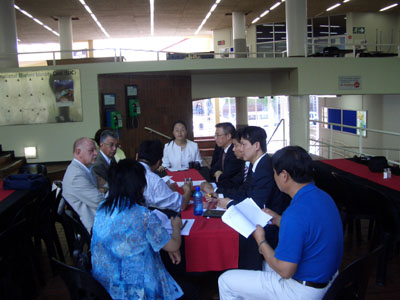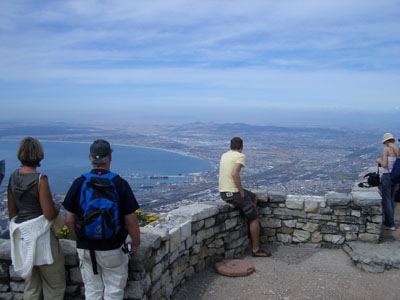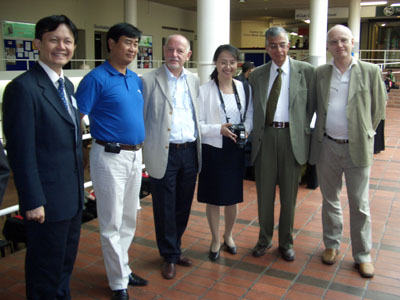我所三位学者参加IUAES南非中期会议
作者:翁乃群、王希恩、张继焦
日期:2007-02-06
浏览次数:1979

与 IUAES主席、副主席和秘书长等有关领导一起召开工作会议

鸟瞰开普敦市(海湾地处:大西洋南岸;观看地点:在著名的桌山上

难得一见。与 IUAES主席、副主席和秘书长等几位领导合影

一份《南非华人报》
在我院国际合作局国际处的资助下,我所三位研究员翁乃群博士、王希恩博士、张继焦博士等,于2006年12月3-7日出席了在南非开普敦市召开的国际人类学与民族学联合会(IUAES)中期会议。
一、参加IUAES南非中期会议的背景、意义和成果
IUAES是在联合国教科文组织注册的人类学和民族学界最具影响的世界性组织。IUAES每5年举办一次规模为3000—5000人世界大会,两届世界大会期间每年都举办一次中期会议(简称“IUAES南非中期会议”)。
从1983年起到现在,23年间,民族所一直积极参加IUAES举办的世界大会和中期会议,是中国申办和筹备IUAES(2008)国际人类学民族学世界大会(简称“2008世界大会”)最主要的学术机构之一。中国于2003年已经获得2008世界大会举办权。在筹备2008年世界大会中,民族所主要承担学术组织的主要职责。
参加IUAES南非中期会议,一方面,使我们有机会与IUAES有关领导进行交流,会议期间专门召开了两次与中国筹备工作有关的工作会议和一次公开说明会。IUAES的主席瓦格斯教授(墨西哥)、副主席斯高尼可教授(捷克)和斯皮格教授(南非)、秘书长纳斯教授(荷兰)、执委哈里森教授(美国)等5位领导出席了工作会议和信息发布会;另一方面,我们也观摩了外国同行的办会经验,增强了我们与国际同行的学术交流和联系,为办好2008年世界大会做准备。
二、IUAES南非中期会议的基本情况
本次会议由国际人类学与民族学联合会(International Union of Anthropological and Ethnological Sciences,简称“IUAES”)、泛非洲人类学家联合会(Pan-African Association of Anthropologists,简称“PAAA”)和南非人类学会(Anthropology Southern Africa,简称“ASnA”)联合主办,由开普敦大学承办。本次会议既是国际人类学与民族学联合会(IUAES)的中期会议,也是泛非洲人类学联合会和南非人类学会的2006年会。
约有来自40多个国家的200多位学者出席了这次会议。
本次会议的主题是“超越后殖民状态:通向可选择的现代性”。
本次会议的场地安排在开普敦大学上校区(该校依山而建,故其校园分为上、中、下三个校区)的乐斯利尔社会科学大楼里,每天有5个会场同时召开多场专题会议。共举行了91个专题会议。专题会议的主题主要有:全球化世界的后殖民状况与日常生活经验、多样的现代性与惯常的社会经验和实践、种族主义、社会性别仇视、性别歧视及其非连结性/连接性、全球政治经济结构及其非连接性/连接性、人类学与科学和技术的不容易的联系:医学、“发展”、伦理学、资本主义、数字信息体系、后殖民背景下的人类学地位、环境、文化遗产与社会建构的关系、迁移、散居和认同建构、作为民族志症候群的民族国家、面对社会政治结构压制的表演和其他抵抗模式、全球化世界中的现代社会运动等。
这次会议除了有众多不同主题的专题会议之外,还有连续3天的人类学影视展映和研讨,部分国家学术机构的小型展览(主要是图片和绘画作品)和小型图书展卖,还有一些国家的学术团体在会议期间设立了专门的活动咨询台,招收会员。
Transcending postcolonial conditions: Towards alternative modernities
A joint conference comprising an
inter-congress of the
International Union of Anthropological and Ethnological Sciences
and the
2006 annual conferences of the
Pan-African Association of Anthropologists
and
Anthropology Southern Africa
3 – 7 December 2006 (Sun-Thurs), University of Cape Town
Theme: Transcending postcolonial conditions: Towards alternative modernities
The postcolonial predicament traverses north and south, structurally connecting all of the world’s marginalised people, wherever they are. The modernising process implemented by European colonialism, and which endures to the present, succeeded in incorporating vast portions of the world’s population, only then to push many to the global political-economic periphery. Moreover, as has been shown for areas of the Pacific rim where Europe’s colonial presence was not so marked, alternative modernist structures have arisen. The question that arises is whether those alternatives are also structurally such that they will drive many to their margins, or whether the new connectivities they create will be more stable than has been the case for the postcolonial world.
To a large extent the postcolonial condition has been shown to be marked by intermittent and often broken connections that draw people into overarching structures and simultaneously push them to the edges of the institutions that predominate within those structures. Some of these patterns are repeated in contemporary capitalist and imperialist projects. Yet in all such contexts one finds social processes at work whereby people strive to connect and reconnect in new ways, establishing and maintaining diverse social, economic and political links, both between themselves and with the rest of the increasingly globalising world. While seeming to promise a new kind of connectivity of citizenship, all too often those connections too have become ever more intermittent, and sometimes broken. Such conditions are very marked in postcolonial states. But they are also increasingly experienced by the metropolitan ‘first world’s’ own marginalised people and by people in ‘second world’ countries and regions that, having thrown off the shackles of empire, now find their connectivity rather more tenuous than had been anticipated, both to centres of power and to each other. And we need to ask, therefore, whether the processes that create alternative modernities in postcolonial and other emerging modern states are structurally as distinctive as the rhetoric of alterity in modernity might suggest.
The conference theme requires work that is situated in a broad structural and historical context. Its goal is to attract papers that focus ethnographically, and use anthropological theory, on a range of interconnectivities. The theme also aims to attract papers that reveal how people strategise to overcome the obstacles of interrupted connections, and the tactics they adopt to deal with such obstacles, thus attempting to transcend, or successfully transcending, their postcolonial conditions. A further goal is to use such empirically-grounded analyses to generate discussion about alternative modernist state and inter-state structures, interrogating the extent to which those structures produce solidary social forms rather than, once again, centres and peripheries between which the connections are primarily in the interests of the centres.
一、参加IUAES南非中期会议的背景、意义和成果
IUAES是在联合国教科文组织注册的人类学和民族学界最具影响的世界性组织。IUAES每5年举办一次规模为3000—5000人世界大会,两届世界大会期间每年都举办一次中期会议(简称“IUAES南非中期会议”)。
从1983年起到现在,23年间,民族所一直积极参加IUAES举办的世界大会和中期会议,是中国申办和筹备IUAES(2008)国际人类学民族学世界大会(简称“2008世界大会”)最主要的学术机构之一。中国于2003年已经获得2008世界大会举办权。在筹备2008年世界大会中,民族所主要承担学术组织的主要职责。
参加IUAES南非中期会议,一方面,使我们有机会与IUAES有关领导进行交流,会议期间专门召开了两次与中国筹备工作有关的工作会议和一次公开说明会。IUAES的主席瓦格斯教授(墨西哥)、副主席斯高尼可教授(捷克)和斯皮格教授(南非)、秘书长纳斯教授(荷兰)、执委哈里森教授(美国)等5位领导出席了工作会议和信息发布会;另一方面,我们也观摩了外国同行的办会经验,增强了我们与国际同行的学术交流和联系,为办好2008年世界大会做准备。
二、IUAES南非中期会议的基本情况
本次会议由国际人类学与民族学联合会(International Union of Anthropological and Ethnological Sciences,简称“IUAES”)、泛非洲人类学家联合会(Pan-African Association of Anthropologists,简称“PAAA”)和南非人类学会(Anthropology Southern Africa,简称“ASnA”)联合主办,由开普敦大学承办。本次会议既是国际人类学与民族学联合会(IUAES)的中期会议,也是泛非洲人类学联合会和南非人类学会的2006年会。
约有来自40多个国家的200多位学者出席了这次会议。
本次会议的主题是“超越后殖民状态:通向可选择的现代性”。
本次会议的场地安排在开普敦大学上校区(该校依山而建,故其校园分为上、中、下三个校区)的乐斯利尔社会科学大楼里,每天有5个会场同时召开多场专题会议。共举行了91个专题会议。专题会议的主题主要有:全球化世界的后殖民状况与日常生活经验、多样的现代性与惯常的社会经验和实践、种族主义、社会性别仇视、性别歧视及其非连结性/连接性、全球政治经济结构及其非连接性/连接性、人类学与科学和技术的不容易的联系:医学、“发展”、伦理学、资本主义、数字信息体系、后殖民背景下的人类学地位、环境、文化遗产与社会建构的关系、迁移、散居和认同建构、作为民族志症候群的民族国家、面对社会政治结构压制的表演和其他抵抗模式、全球化世界中的现代社会运动等。
这次会议除了有众多不同主题的专题会议之外,还有连续3天的人类学影视展映和研讨,部分国家学术机构的小型展览(主要是图片和绘画作品)和小型图书展卖,还有一些国家的学术团体在会议期间设立了专门的活动咨询台,招收会员。
Transcending postcolonial conditions: Towards alternative modernities
A joint conference comprising an
inter-congress of the
International Union of Anthropological and Ethnological Sciences
and the
2006 annual conferences of the
Pan-African Association of Anthropologists
and
Anthropology Southern Africa
3 – 7 December 2006 (Sun-Thurs), University of Cape Town
Theme: Transcending postcolonial conditions: Towards alternative modernities
The postcolonial predicament traverses north and south, structurally connecting all of the world’s marginalised people, wherever they are. The modernising process implemented by European colonialism, and which endures to the present, succeeded in incorporating vast portions of the world’s population, only then to push many to the global political-economic periphery. Moreover, as has been shown for areas of the Pacific rim where Europe’s colonial presence was not so marked, alternative modernist structures have arisen. The question that arises is whether those alternatives are also structurally such that they will drive many to their margins, or whether the new connectivities they create will be more stable than has been the case for the postcolonial world.
To a large extent the postcolonial condition has been shown to be marked by intermittent and often broken connections that draw people into overarching structures and simultaneously push them to the edges of the institutions that predominate within those structures. Some of these patterns are repeated in contemporary capitalist and imperialist projects. Yet in all such contexts one finds social processes at work whereby people strive to connect and reconnect in new ways, establishing and maintaining diverse social, economic and political links, both between themselves and with the rest of the increasingly globalising world. While seeming to promise a new kind of connectivity of citizenship, all too often those connections too have become ever more intermittent, and sometimes broken. Such conditions are very marked in postcolonial states. But they are also increasingly experienced by the metropolitan ‘first world’s’ own marginalised people and by people in ‘second world’ countries and regions that, having thrown off the shackles of empire, now find their connectivity rather more tenuous than had been anticipated, both to centres of power and to each other. And we need to ask, therefore, whether the processes that create alternative modernities in postcolonial and other emerging modern states are structurally as distinctive as the rhetoric of alterity in modernity might suggest.
The conference theme requires work that is situated in a broad structural and historical context. Its goal is to attract papers that focus ethnographically, and use anthropological theory, on a range of interconnectivities. The theme also aims to attract papers that reveal how people strategise to overcome the obstacles of interrupted connections, and the tactics they adopt to deal with such obstacles, thus attempting to transcend, or successfully transcending, their postcolonial conditions. A further goal is to use such empirically-grounded analyses to generate discussion about alternative modernist state and inter-state structures, interrogating the extent to which those structures produce solidary social forms rather than, once again, centres and peripheries between which the connections are primarily in the interests of the centres.
文章来源:张继焦